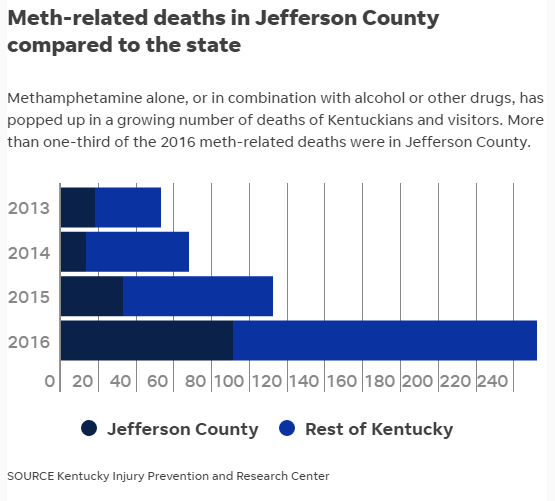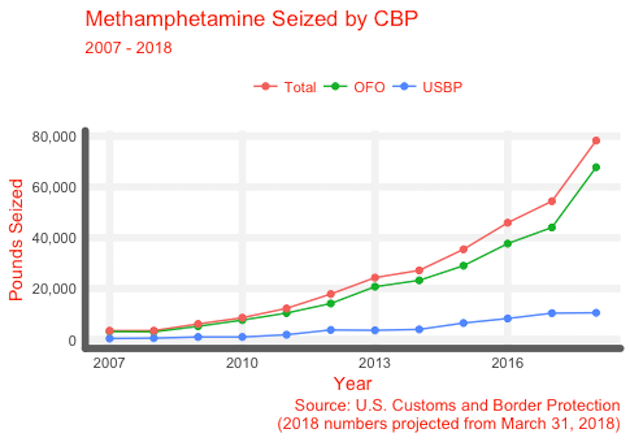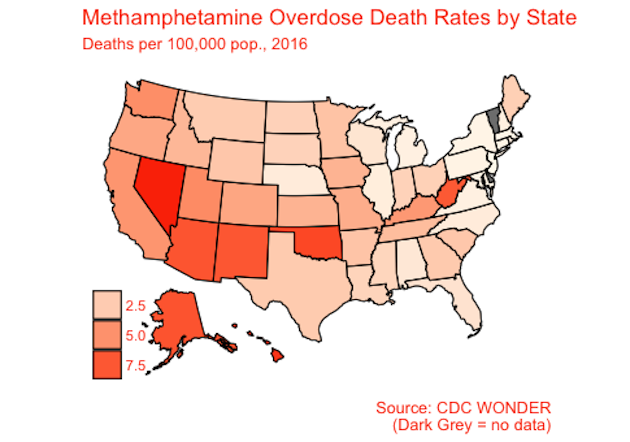While Louisville deals with an opioid crisis that claimed the lives of more than 20,000 people in 2016, a new threat in the form of highly synthesized and purified crystal meth is now rearing its head. While meth never disappeared, it has made a resurgence in Kentucky where meth-related deaths more than tripled from 2013 to 2016, totaling 252 casualties. In 2017 alone, there were more than 100 overdose deaths in Jefferson County involving meth or a mixture of it and other drugs. Kentucky isn’t alone in this: across the nation, deaths related to stimulant overdoses rose by more than one third between 2015 and 2016, totaling 7500 deaths.

The Rise of Meth Labs
Before 2005, methamphetamine was produced mainly in dangerous homemade labs across the United States. The Combat Methamphetamine Epidemic Act of 2005, passed by George Bush, was intended to curtail the sales of cold and allergy medicines that contained pseudoephedrine, ephedrine, and phenylpropanolamine, all ingredients in meth. This act severely cut down on the number of home labs.
However, Mexican cartels took up the responsibility of fulfilling the supply to meet demand and began mass producing the drug on a scale unseen before. Statistics show that the number of domestic meth labs in the U.S. declined continuously since 2010 and hit a decade low in 2016. However, the amount of methamphetamine seizures at the border has increased continually since 2008. Cartels have saturated the market with higher quality, pure methamphetamine. This batch of meth, dubbed ice, looks like chunks of blue tinted glass and is twice the quality of the average street meth you would have found 15 years ago. In Louisville, as the drug has flooded the streets, the price has dropped to as low as $300 an ounce, according to Louisville Metro Police Sgt. Paul Neal.
Whereas 20 years ago the drug was produced in homemade meth labs using cold medicine purchased from drug stores, today’s meth from south of the border is sometimes cut up with fentanyl, the deadly opioid. Cartels cut batches of methamphetamine and heroin with the synthetic opioid fentanyl to make their product seem even better. They’re not attempting to kill their customers – that would be stridently anti-capitalistic – but they are increasing the risk of killing first-time customers if they ingest the substance without knowing that it is laced with fentanyl.

While pure opioid overdoses have claimed more lives than pure methamphetamine overdoses, there is at least a chance to reverse the former. The opioid antagonist Naloxone can reverse the effects of an opiate overdose and save lives, but a methamphetamine overdose is a one-way train, and there’s not much that responding personnel can do to stop a stimulant overdose.
In Daviess County, Kentucky, Sheriff Keith Cain says that his region doesn’t have an opioid problem. One treatment center, RiverValley Behavioral Health has seen a considerable drop in heroin and opioid-related cases, but the reason isn’t a healthier community more aware of the dangers of drug use. Sheriff Cain states: “Why doesn’t Daviess County have an opioid problem? I’d like to say it’s because of progressive police work. But I think the prime reason we don’t have an opioid problem is that our people are addicted to meth”.

http://freebeacon.com/issues/analysis-meth-crisis-america/
Why is Meth Getting Stronger?
The potency of methamphetamine has been increasing over the past decade as production as shifted from domestic home labs to Mexican super labs. The shift in production is due to regulatory laws making it more difficult to purchase the ingredients in the U.S., which while helpful in curtailing domestic production, has only allowed foreign agents to expand their production and refine their techniques.
According to the Iron Law of Prohibition, first coined by Richard Cowan in 1986, the prohibition of any drug leads to increased potency as the volume is reduced to enhance smuggling ability. This law was on display in the U.S. during prohibition in the 1920s, where moonshine became a favorite drink because of its high alcohol content.
What is Methamphetamine?
Methamphetamine is a human-made stimulant that comes in many forms. The purest form is crystal meth, which comes in crystal chunks that have a blue-white tint. Users can smoke crystal meth with a small glass pipe, swallow it, snort it, or inject it directly into the veins. Methamphetamine is a Schedule II drug because of its limited medicinal potential. Pharmaceutical grade methamphetamine (Desoxyn) has seen limited clinical application for the management of attention deficit hyperactivity disorder (ADHD).
How Does Methamphetamine Enter the Body?
Both methamphetamine and amphetamine enter the bloodstream quickest by injecting or smoking. Unlike cocaine, both drugs are also effective when taken orally, because they do not get broken down by the liver nearly as quickly. Both drugs take longer for the body to dissolve fully, so the effects typically last much longer than cocaine.
How Does Methamphetamine Work?
Meth is a powerful stimulant that affects the brain, central nervous system, and spinal cord. It acts on the neurotransmitters responsible for dopamine. Dopamine gets released in large quantities when using meth, creating a rush of euphoria during which heart rate, blood pressure, and libido all increase. The comedown associated with meth usage is commonly called tweaking because the ensuing crash leaves the user depleted of feel-good chemicals and with the anxiety and fear synapses of the brain firing off.
History of Methamphetamine
For a long time, the Chinese drug mahuang was associated with treating breathing symptoms of asthma. Eventually, the compound ephedrine was identified and distilled as the chemical responsible for the medical benefits of mahuang. A synthetic version of ephedrine was created a few years afterward by Gorden Alles in 1885 and became known as amphetamine. The drug quickly became marketed and sold throughout the United States and Europe as a nasal inhaler that did a lot more than just open the bronchioles. Usage increased throughout the 1930’s, and in Japan, the synthetic compound methamphetamine became widely popular. During World War II, drug use in war was on the rise as soldiers from every side used amphetamines and methamphetamines to maintain alertness during extended tours of duty.
Following the war, waves of stimulant usage affected the United States and other countries to varying degrees. A wave of amphetamine usage characterized the 60’s, followed by its restriction to medical use only in 1971. Cocaine abuse followed this methamphetamine craze during the 1970’s. As soon as this ended, the crack epidemic of the 1980’s began. The crack epidemic was followed by the rise of methamphetamine in the 1990’s, which increased even more in the 2000’s. Today, methamphetamine is widely produced in home labs across the world. From 2010 to 2014, the number of overdose deaths from methamphetamine more than doubled, and from 2013 to 2016 that number increased by one third.
Short-Term Side Effects of Meth
- Difficulty with motor function
- Loss of appetite
- Arrhythmias
- Heart palpitations
- Stroke
- Seizure
- Skin sores
- Anxiety
- Insomnia
- Confusion
- Violent behavior
- Cognitive dysfunction
- Memory loss
- Paranoia
- Hallucinations
Long-Term Side Effects of Meth
- Paranoid
- Depression
- Fatigue
- Suicidal Thoughts
- Nightmares
- Insomnia
- Increased Appetite
- Anhedonia
- Increased Risk of HIV and Hepatitis
- Rotted Teeth
How is Meth Made?
Because methamphetamine is a synthetic drug, it is readily available to be produced anywhere in the world. The ingredients are both powerful and cheap, making methamphetamine a dangerous and ubiquitous drug. Meth is primarily made from extracting ephedrine or pseudoephedrine out of cold medicines through a number of chemical reactions. The chemicals used include:
- Acetone
- Lithium
- Toluene
- Hydrochloric Acid
- Phosphorous
- Pseudoephedrine
- Sodium Hydroxide
- Sulfuric Acid
- Anhydrous Ammonia
A vast majority of these chemicals are extremely toxic while others are highly volatile and flammable. The typical products you can get these chemicals from include nail polish remover, drain cleaner, cold tablets, batteries, paint thinner, and freon. These dangerous ingredients are part of the reason that meth labs have a reputation for exploding, either killing or badly burning occupants.
Shake and Bake Method
One of the more dangerous methods of meth production has seen a rise in recent years due to its simplicity. The shake and bake method has overtaken the lengthy, complicated process of traditional meth cooking because all it involves is a water bottle and some of the ingredients listed above. Instead of using a laboratory, all you have to do is mix the ingredients in a plastic water bottle and shake. It produces significantly less meth than the traditional method, but it’s appealing because it can be done in 15 minutes inside of a Walmart.
Facts About Meth
- The National Survey on Drug Use and Health found that lifetime prevalence of methamphetamine for Americans in the age group of 12 to 17 was 0.30%, while prevalence for ages 18 to 25 rose to 2.4% and ages 26 and older was 6.5%
- The number of drug overdose deaths that involved methamphetamine increased from 1388 in 2010 to 3728 in 2014.
- The TEDS report (National Treatment Episode Data Set) reported that in 2014 approximately 53 people per every 100,000 received care at a specialized addiction treatment facility specifically for methamphetamine problems.
- Meth can be injected, snorted, and swallowed by users. Depending on the dosage and potency, the effects can last from four to eight hours or more.
- Methamphetamine increases brain activity, suppresses appetite, and induces a sense of euphoria in the body and mind. It has been used for weight control, attention deficit hyperactivity disorder, mild depression, endurance, and to stay awake.
- Prolonged abuse of methamphetamine can induce insomnia, appetite loss, increased blood pressure, paranoia, aggression, psychosis, mood swings, hallucinations, disordered thinking, and self-induced injuries. Users of the drug frequently become run down because they stop paying attention to their health and hygiene. Usage also leaves users susceptible to illness. Addicts who quit cold turkey may experience extreme withdrawal effects such as depression, fearfulness, anxiety, and lethargy.
- Meth is produced in laboratories using a variety of volatile and toxic chemicals. Frequently these laboratories may combust due to improper handling of the ingredients, injuring or killing the occupants and spreading fires to neighboring structures.
- Pharmaceutical methamphetamine is available through prescription under the name Desoxyn but is not frequently prescribed because of the aforementioned side effects. It is never used as a long-term medication and is only prescribed for short-term fixes. Pharmaceutical amphetamine is much more common and is available in prescription medication form under brands such as Adderall, Ritalin, and Vyvanse. These medicines are prescribed to help treat narcolepsy, attention deficit hyperactivity disorder, depression, and fatigue. Amphetamine is commonly used to enhance alertness or keep people awake for prolonged periods of time.
- Although public campaigns may say otherwise, methamphetamine is not an immediately addicting drug. For some, the euphoric high gets them hooked on the first go, but many people who use methamphetamine do not develop an addiction to the drug. Because it is more long-lasting than cocaine, treatment centers have a harder time helping people who are hooked on this drug comparatively.
- Although methamphetamine is on the rise, the number of Americans who have reported binge drinking in the last month is more than 90 times the number who reported using meth in the same period.
Treating Meth Addiction
The longer someone abuses meth, the more severe the withdrawal symptoms will be. A high level of dependence can make abstaining from this drug extremely difficult. The best way to ensure safe withdrawal is to go through a medical detox program. There are no specific medications directly tied to methamphetamine withdrawal, but any prescriptions that address depression, anxiety, and insomnia are helpful. It is essential to recognize the early signs of meth addiction and to get someone into a treatment center as soon as possible to achieve the best possible odds of sobriety.
In Conclusion
Drug and alcohol addictions are some of the most destructive forces in the world today, especially if the addiction is to stimulant drugs. The process of healing ourselves, our families, our communities, and the world at large, starts with recognizing the danger that these substances represent. At Landmark Recovery, we believe in creating a supportive network of love and access to resources that can help you break free from the chains of addiction. Visit our website to learn more about drug and alcohol recovery today.

Choose Recovery Over Addiction
We're here 24/7 to help you get the care you need to live life on your terms, without drugs or alcohol. Talk to our recovery specialists today and learn about our integrated treatment programs.



